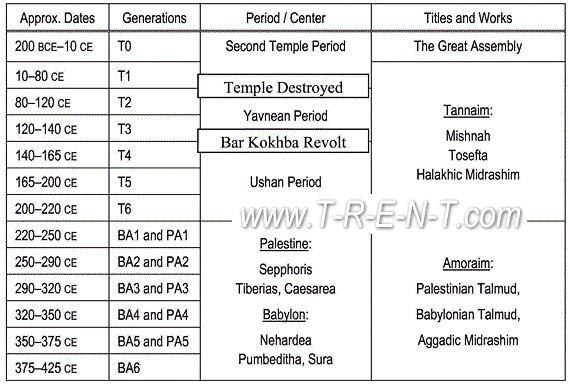What are the word in bold?
Bold marks quotes
from Mishnah within in the Talmuds. The Talmuds are commentaries on
Mishnah, so a each section starts with a quotation and individual
words or phrases are cited wihin the comments.
What are the dotted underlings?
Individual words
with dotted underlining are technical terms. Simple meanings for
these terms are available when you hover over these words. These
definitions come from the TRENT
project, and not from the printed versions of the translations.
What are the words in italics?
Phases or sections
in italics in the Tosephta are quotations, usually from the Mishnah, but
also from the BIble.
Phrases or sections in italics in the Jerusalem
Talmud marks sections of where Hebrew is used instead of
Aramaic.
What is [T1] or [BA3] etc ?
The texts on this site
have been marked up with clues about dating the individual rabbis. These
dates have been assigned 'automatically', and may occasionally be wrong.
This kind of infomation should not be taken as definitive way to date an
individual tradition, though it is a good starting point. See the
Introductory chapter of Traditions
of the Rabbis in the Era of the New Testament.

What is [1.2]? - References in square
brackets
When the text divisions in Hebrew Bavli and the
Mishnah MSS differ, the Mishnah is displayed in square brackets as an
alternative, so that the Mishnah and Talmud tie up conveniently. (In
the original MTR text, the Babli reference is in square brackets
instead).
What are the original languages?
The original
languages are Hebrew and Aramaic. Mishnah and Tosephta are mainly in a
form of Hebrew which can be called Mishnaic Hebrew with occasional phrases
in Aramaic. The vocabulary of Mishnaic Hebrew is similar to to Biblical
Hebrew, though the grammar has leanings towards to Aramaic. The Talmuds
are written in Aramaic though MIshnaic Hebrew is used for quotations of
MIshnah and occasional other phrases. Talmudic Aramaic is related to
Hebrew but has a significantly different vocabulary and grammar, and the
language has developed considerably from the Biblical Aramiac found in
Daniel.